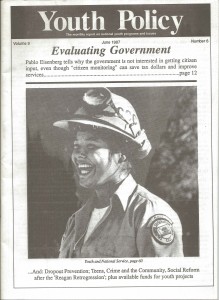Roger Herrera, 15 year old student, Dallas, Texas at NCPC’s training, Washington, DC in February, 1986
Roger Herrera’s remark beautifully embodies the National Crime Prevention Council’s beliefs which undergird our programs for teens-the affirmation that teens are part of something larger, that teens can (and have a desire to) take responsibility for a part of the contexts in which they live and that they can help take responsibility for the safety and well being of others. Few know of what positive community resources teens can be; still fewer know of the appallingly high rates often victimization (twice that of the general population) and what teens can do to reduce- victimization and contribute to improving conditions which can cause crime.
A Note of Philosophy
By utilizing the talents, skills and ideas in community service, we seek to prove that teens do not have to be seen as a source of problems, but can be part of the solution. Our goal is to develop and nurture the link adolescents want and need with their communities, a social and economic milieu in which most of their adult lives will be conducted. Most teens are judged by academics or sports yardsticks. Other measures must be found. It is on the local level that teens first receive the sense of self-via family…school, community and work. It is there, on the community level, that we will start rebuilding the basic blocks of our society.
Communities, to their delight and surprise, will be rewarded, manifold for creating meaningful roles for their young citizens. We seek to prove that teens can demonstrate their effectiveness as a functioning part of the body politic. . We seek to prove that the teen years do not automatically usher in a decade of trouble.
This is not an isolated or episodic problem. It is endemic to our society -, Puberty occurs earlier and earlier, yet society cannot or will not find meaningful roles for teens until later and later. We see the results in increasing numbers of teen violent crime, skyrocketing teen pregnancy rates, a disturbing number of teens being committed to adolescent psychiatric wards and increases in teen runaways and teen suicides. We have not given teens the opportunity to explore and integrate themselves into the social fabric they will share as adults. Refused partnership in the social contract, teens may display a variety of symptoms which reflect dislocation and, isolation.
The bulk of literature on adolescence concentrates Oil’ pathology. But adolescence is also characterized by striving for achievement and competence. This view of the adolescent is radically different from social stereotypes, but is rarely mentioned. Gisela Konopka talks about adolescence as:
An age of commitment, a move into true interdependence. Commitment includes a search for one’s identity but also points toward the emotional, intellectual, and sometimes physical reach for other people as well as ideas, ideologies, causes, work choices. To acknowledge adolescence as an age of commitment is to elevate it from’ a stage to be endured and passed through as rapidly as possible to a stage of earnest and significant human development …
-Gisela Konopka, “Requirements/or Healthy Development of Adolescent Youth,” Adolescence, 1973.
The irony is that teens are available and have the desire …to help while local communities have needs which cry out for: assistance-ranging from recreation through day care through work with the elderly, to work in hospitals.
In the long term we seek nothing less than an alteration in the way our society perceives and integrates its young people. Communities will become more vital, safer and healthier because of what their teenage members have done for all. Teenagers will have a chance to gain responsible experience and to put their talents to work positively. Community attitudes .and agency policies will affirm teens’ roles and competence.
Recent History
I have personally seen this concept work. During my term as Commissioner of Youth Services in Massachusetts, we applied it to delinquent youth. Teens met their victims and gave something back, either to victim or community. Young offenders escorted the elderly while they cashed Social Security checks, tutored younger children, cleaned up parks, worked in day care centers, etc. The message was dual: “You are responsible; you are needed.” The results were heartening.
In May 1985, NCPC completed a book for the Ford Foundation entitled Making A Difference. In it we recorded examples where teens served as community resources. The programs were remarkable: sports stars counseling fourth through eighth graders about drug and alcohol abuse in Huntingburg, Indiana; “Big Buddies” in Cleveland where high school juniors and seniors tutored troubled second and third graders to the benefit of each; Hispanic kids in San Antonio painting murals on graffiti-strewn walls; teens working with the PTA, teachers and police to clean up a crime-plagued high school in Miami (the weapon detectors and patrolling police officers were removed); gangs cleaning up graffiti in the metro system in Oakland, California.
Teens and Community
Our belief is being made manifest in two specific projects. The first is the Teens as Community Resources project in Boston, Massachusetts. Designed last year by the National Crime Prevention Council in conjunction with the Boston Foundation and key individuals in Boston, most notably Dr. Deborah Prothow-Stiih, the project draws from our central philosophy for its specific goals:
- To affirm teens’ capacity to work in responsible roles and make significant contributions to school and community betterment;
- To learn how school and communities can create and sustain attitudes and opportunities which permit and encourage teen participation in the building of better schools and communities;
- To alter policies and procedures of agencies which work with teens (e.g., schools) to include a youth-as-resources dimension;
- To alter policies and procedures of those agencies which can benefit form teen talents (e.g., hospitals, day care centers, etc.) to include a teens-as-resources dimension;
- To implement strategies for shifting public opinion toward an affirmation of teens as positive community resources;
- To learn the significance of what happens to the attitudes and perceptions of young people when involved in service projects.
The project, which will expand to three additional cities in another state this summer, is relatively simple in its construction. A board, made up of a teen representative and key individuals whose functions impinge on youth, provides grants for locally-generated teen community service projects.
Projects must meet at least three criteria: they are run by teens with adult assistance, for the community (not projects by adults, for kids); they are deemed important by the community; and they are projects through which teens receive some public recognition. Selected form a number of applicants, the Boston board funded:
The Log School in Dorchester where teens, noting hunger among neighborhood residents, have started working in a food bank and food distribution work in conjunction with students from Brimmer and May, a prep school on the outskirts of Boston. Said one participant, Ronnie Fitzgerald, a 13-year-old Dorchester resident: “I’ve been on the other side so I know what it’s like to be in their shoes. I used to pick up cheese and butter for my family at a school in Dorchester. Now I’m just glad to be on the other side … It’s kind of like paying somebody back.”
At English High School’s Fenway Program, teacher Scott Edelman had his students identify the worst problems facing the neighborhood. From 50 issues, the teens culled five: pregnancy, pollution, homelessness, drug abuse and hunger. Space does not permit descriptions of the magnificent student progress, but the activities range from a short video on teen pregnancy prevention to a walk for hunger.
Hayden Goodwill School, a nontraditional school, has had problems with the residents who want them out of the community. Students are providing services to the Citizens’ Association (e.g., beautification of the park and neighborhood).
- The JFK Corps has received a grant from the board to build a tot lot and play area for children whose parents are involved at WOMEN, Inc., a drug and alcohol rehabilitation residence for women and their children.
- Finally, Madison Park High School has designated May as Community Service Month for all graduating seniors.
Teens, Crime and the Community
- The second major project was launched by NCPC in conjunction with the National Institute for Citizens Education in the Law, a curriculum called Teens, Crime and the Community which addresses two central problems:
- Astronomical victimization rates. While all know that teens commit crimes in disproportion to their numbers, few realize their high rates of victimization (they are victims of assault more than 11 times that of those over 65).
- The need to engage teens as positive agents in making their schools and communities safer and better.
The curriculum, easily woven into civics, social studies, history or health classes, addresses the phenomenon and incidence of crime and victimization, discusses crime reduction strategies for each of several types of crime, and then asks (with teachers and community resource persons) to design projects which would make their schools and communities safer and better.
In its short, two-year pilot phase, this astonishingly successful project has:
- Started the full program in 11 cities (Cleveland, Dallas, Flint, Miami, Knoxville, New York, Oakland, Phoenix, Portland, Salt Lake City, and St, Louis);
- Launched the curriculum in 156 high schools, reaching roughly 15,000 teenagers;
- Seen the course, Teens, Crime and the Community, made a requirement by the Phoenix Union School District;
Said one participant, Ronnie Fitzgerald, a 13-year-old Dorchester resident: “I’ve been on the other side so I know what it’s like to be in their shoes. I used to pick up cheese and butter for my family at a school in Dorchester. Now I’m just glad to be on the other side … It’s kind of like paying somebody back. ”
Witnessed the creation of teen-led victimization reduction, school/community improvement projects such as peer counseling, student courts, anti-graffiti drives, drug and alcohol abuse prevention plays, city-wide teen councils, etc.;
- Engendered cooperation among teens, teachers, law enforcement, and victim service agencies; and
- Convinced West Publishing Company to publish the curriculum as a formal text this fall.
Mood swings, erratic attention spans, high energy-are all hallmarks of adolescents. But another hallmark; usually overlooked, is that teenagers are idealistic and thirst for commitment and recognition. Society is faced with a choice. We can continue to deal with pathologies and delinquencies, treating symptoms instead of addressing the core issues. Or we can rethink the attitudes and myths about adolescence. We use the word “alienation”, a great deal when it comes to teenagers and we counterpoise that word with “rehabilitation.” But the true opposite of alienation is engagement we can-and must-help and rehabilitate; but let us also, as a society, engage these teens, let us claim them-not just “fix” them. Then, perhaps, we can not only complete needed tasks but help communicate to teens that they are an important part of our society. The challenge for all of us is to conjoin the need of teens for services with a healthy recognition of the need of teens to serve.
John A. Calhoun, Executive Director of the National Crime Prevention Council, was formerly U.S. Commissioner of the Administration for Children, Youth and Families.




Leave a Reply